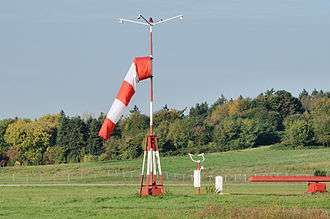Windsock

A windsock is a conical textile tube (which resembles a giant sock, hence its name) designed to indicate wind direction and relative wind speed. Windsocks typically are used at airports and at chemical plants where there is risk of gaseous leakage. They are sometimes located alongside highways at windy locations.
Wind direction is the opposite of the direction in which the windsock is pointing (note that wind directions are conventionally specified as being the compass point from which the wind originates; so a windsock pointing due north indicates a southerly wind). Windspeed is indicated by the windsock's angle relative to the mounting pole; in low winds, the windsock droops; in high winds it flies horizontally.
Per FAA standards referenced below, a 15-knot (28 km/h; 17 mph) wind will fully extend the properly functioning windsock. A 3-knot (5.6 km/h; 3.5 mph) breeze will cause the properly functioning windsock to orient itself according to the wind.
Per Transport Canada standards: a 15-knot (28 km/h; 17 mph) wind will fully extend the wind sock, a 10-knot (19 km/h; 12 mph) wind will cause the wind sock to be 5° below the horizontal, a 6-knot (11 km/h; 6.9 mph) wind will cause the wind sock to be 30° below the horizontal.
At many airports, windsocks are lighted at night, either by flood lights on top surrounding it or with one mounted on the pole shining inside it.
Windsocks are also popular with children and can have bright and colourful designs. These windsocks are not particularly functional and mostly for decoration. However, they can be used as a basic guide to wind direction and speed.
See also
External links
| Wikimedia Commons has media related to Windsocks. |
- FAA Specification for Wind Cone Assemblies FAA Advisory Circular 150/5345-27D (PDF 447KB)
- Transport Canada Aeronautical Information Manual Transport Canada Aeronautical Information Manual (TC AIM) TC AIM - AGA - AERODROMES - 5.9 Wind Direction Indicators